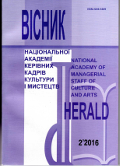MYTHOLOGICAL CODES AND «DOUBLE CODING» IN ART
DOI:
https://doi.org/10.32461/2226-3209.2.2016.138515Keywords:
code, double coding, myth, mythological code, ballet, music, visual arts, theaterAbstract
The purpose of the research is to determine the characteristics of mythological code and "double coding" in various art forms. The research methodology is the use of a systematic approach, which reveals features of mythological codes and the "double coding" in different genres of art. The methodological basis for the study of mythological codes is the concept of Peirce and Saussure, and the principles of "double coding" of R. Barth, Charles Jenks and Lotman. Scientific originality. Based on the study of works of various arts, myths are considered as a system of codes. "Double coding" is revealed in the disclosure of double standards of mythological codes and combination of various codes in one piece of work. Conclusions. Mythological codes are presented in all the arts (dance, music, theater and visual arts). Mythological codes maintain a constant system of quality, by which they are differentiated regardless of interpretation of images and stories. M. Tcherepnin's "Narcissus and Echo" demythologizes the true myth content by means of the art of ballet. Remythologization (replacement of old ideas with new ones) is present in "Pygmalion" by B. Shaw. The allusion to the myth of Ariadne is found in the ballet "Crossroads" by R.Poklitaru.
Downloads
Published
Issue
Section
License
Authors who publish with this journal agree to the following terms:
1. Authors retain copyright and grant the journal right of first publication with the work simultaneously licensed under a Creative Commons Attribution License International CC-BY that allows others to share the work with an acknowledgement of the work's authorship and initial publication in this journal.
2. Authors are able to enter into separate, additional contractual arrangements for the non-exclusive distribution of the journal's published version of the work (e.g., post it to an institutional repository or publish it in a book), with an acknowledgement of its initial publication in this journal.
3. Authors are permitted and encouraged to post their work online (e.g., in institutional repositories or on their website) prior to and during the submission process, as it can lead to productive exchanges, as well as earlier and greater citation of published work (See The Effect of Open Access).


